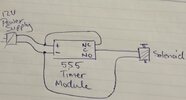Trying to make a circuit with a solenoid that pushes the reset button on a streaming device.
Started this thread earlier in another post but it got kind of long and didn't seem like anybody was following it anymore.
Simple question I hope. For a 12v DC solenoid actuated by this relay https://www.ebay.com/itm/224370769091?hash=item343d8a3cc3:g:q64AAOSw8HpgPbwq&LH_BIN=1 do I need a snubber in the circuit (see attached sketch generated by another member of this forum).
I had never heard of a snubber before (at least not in the context of circuits). Reading around it seems like they are used to prevent arcing at switch contacts. But is the NE555 relay a solid state device? And, if so there aren't any contacts and a snubber wouldn't be needed?
Or, if it isn't solid state can somebody tell me which diode to use in the circuit? And I assume it's wired in parallel between the 2 wires coming out of the solenoid?
Thanks.
Started this thread earlier in another post but it got kind of long and didn't seem like anybody was following it anymore.
Simple question I hope. For a 12v DC solenoid actuated by this relay https://www.ebay.com/itm/224370769091?hash=item343d8a3cc3:g:q64AAOSw8HpgPbwq&LH_BIN=1 do I need a snubber in the circuit (see attached sketch generated by another member of this forum).
I had never heard of a snubber before (at least not in the context of circuits). Reading around it seems like they are used to prevent arcing at switch contacts. But is the NE555 relay a solid state device? And, if so there aren't any contacts and a snubber wouldn't be needed?
Or, if it isn't solid state can somebody tell me which diode to use in the circuit? And I assume it's wired in parallel between the 2 wires coming out of the solenoid?
Thanks.



